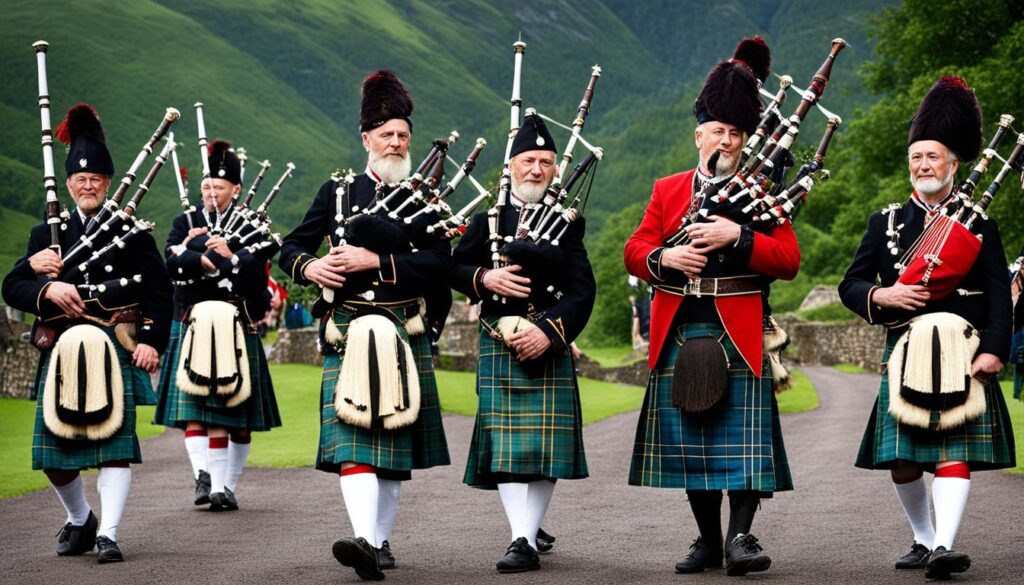Saint Andrew’s Day 2023! In this article, we will explore the date, history, and significance of this significant Scottish celebration. Saint Andrew’s Day is an annual celebration in Scotland, honoring Andrew the Apostle, who is recognized as the country’s patron saint. This day holds great cultural and historical significance for the Scottish people, and it is a chance to embrace Scottish heritage and traditions. Join us as we delve into the fascinating world of Saint Andrew’s Day.

Key Takeaways:
- Saint Andrew’s Day is celebrated in Scotland as the country’s patron saint.
- It is marked annually on November 30th.
- The celebration has a long-running tradition but many may be unsure about the reasons behind it.
- Saint Andrew is also the patron saint of other countries and cities around the world.
- Scottish people celebrate the day with parties, games, traditional food, and music.
Why do we celebrate St Andrew’s Day?
St Andrew’s Day is a joyous celebration that holds a special place in Scottish tradition and culture. This annual event, observed on November 30th, commemorates Andrew the Apostle, who is the patron saint of Scotland. But why do the Scottish people celebrate this day with such enthusiasm?
The roots of St Andrew’s Day celebration go back to 1320 when Andrew was officially chosen as Scotland’s patron saint. At the time, Scotland sought protection against English conquest, and Andrew’s connection to Saint Peter, the founder of the church, made him a fitting choice. Since then, this day has been an opportunity for Scots to honor their heritage and pay tribute to the country’s patron saint.
The significance of St Andrew’s Day is not limited to historical reasons alone. It also carries a deep sense of national pride and identity for the Scottish people. The celebration is a way of reaffirming their cultural roots, strengthening community bonds, and showcasing the rich traditions that make Scotland unique. From traditional Scottish music and dance to indulging in delicious Scottish food, the festivities are a vibrant display of Scottish heritage.
You can also read Easy Ways to Prevent Mould & Mildew Growing in Home
The Symbolism of St Andrew
Andrew’s influence on Scottish history and mythology further contributes to the significance of St Andrew’s Day. Legends speak of his role in the conversion of early Scots to Christianity and the establishment of a church in Fife, Scotland. His symbol, the X-shaped cross or saltire, has become an integral part of the Scottish flag, representing the enduring spirit of the nation.
| Why do we celebrate St Andrew’s Day? | Reason |
|---|---|
| Historical Significance | Andrew chosen as Scotland’s patron saint in 1320 |
| Cultural Pride | Reaffirming Scottish heritage and traditions |
| Community Celebration | Bringing Scots together through music, dance, and food |
| Symbol of Scotland | Andrew’s influence and the Scottish saltire |
Saint Andrew as a patron saint in other countries
Saint Andrew is not only the patron saint of Scotland but also of other countries. Here are some countries and cities that have Saint Andrew as their patron saint:
Barbados
Saint Andrew is the patron saint of Barbados, an island country in the Caribbean. The influence of Saint Andrew can be seen in the cultural traditions and celebrations of the Barbadian people.
Romania, Ukraine, and Russia
Saint Andrew is also widely revered in countries such as Romania, Ukraine, and Russia. Churches and monuments dedicated to Saint Andrew can be found in these countries, showcasing his significance and influence.
You can also read Remembrance Day 2023 and poppy color meaning
Pienza, Amalfi, Esgueira, Luqa, Parañaque, Patras
Several cities around the world have adopted Saint Andrew as their patron saint. Pienza and Amalfi in Italy, Esgueira in Portugal, Luqa in Malta, Parañaque in the Philippines, and Patras in Greece all have a special connection to Saint Andrew and commemorate him in various ways.
Through his influence as a patron saint, Saint Andrew has left a lasting impact not only in Scotland but also in many other countries and cities across the globe.
| Country / City | Significance |
|---|---|
| Barbados | Patron saint |
| Romania | Patron saint |
| Ukraine | Patron saint |
| Russia | Patron saint |
| Pienza (Italy) | Patron saint |
| Amalfi (Italy) | Patron saint |
| Esgueira (Portugal) | Patron saint |
| Luqa (Malta) | Patron saint |
| Parañaque (Philippines) | Patron saint |
| Patras (Greece) | Patron saint |
Who was Saint Andrew?
Saint Andrew, also known as Andrew the Apostle, was a disciple of Jesus Christ and holds significant importance in Christianity. He was born and lived in Galilee, where he worked as a fisherman before being called to follow Jesus. Andrew had a close relationship with his brother, Simon Peter, who would later become one of the foremost leaders of the early Christian church.
As one of Jesus’s twelve apostles, Andrew witnessed many important events in his life, including the Last Supper and the crucifixion. After Jesus’s death and resurrection, Andrew played a crucial role in spreading the teachings of Christ, traveling to various regions to share the gospel. His missionary work in Greece and Asia Minor led to the conversion of many people to Christianity.
However, Andrew’s dedication to spreading the message of Christ ultimately led to his martyrdom. He was crucified on an X-shaped cross in Patras, Greece, around AD 60. Despite the tragic end to his life, Andrew’s influence as a disciple and martyr continues to resonate in the Christian faith, and he is honored as the patron saint of Scotland and several other countries.
Key Points:
- Saint Andrew was a disciple of Jesus Christ and the brother of Saint Peter.
- He was a fisherman by trade and lived in Galilee.
- Andrew played a significant role in spreading the teachings of Jesus and converting people to Christianity.
- He was martyred through crucifixion in Patras, Greece, around AD 60.
- Saint Andrew is honored as the patron saint of Scotland and several other countries.
Now that we have explored the life of Saint Andrew and his significance, let us delve deeper into why St Andrew’s Day is celebrated and how Scottish people honor their patron saint on this special occasion.
Why is St Andrew the patron saint of Scotland?
St Andrew being the patron saint of Scotland is steeped in legend and historical significance. One popular legend claims that King Angus of Scotland witnessed an X-shaped cross in the sky before a decisive battle and took it as a sign from St Andrew, promising him victory. This legend reflects the deep connection between St Andrew and the people of Scotland, as his supposed intervention in a crucial moment of the country’s history has been honored ever since.
Another legend surrounding St Andrew’s importance to Scotland comes from the belief that the Scottish people are descended from an ancient population known as the Scythians, who St Andrew personally converted to Christianity. This notion of St Andrew as the spiritual founder of Scotland’s Christian heritage further solidified his status as the patron saint of the country.
The association between St Andrew and Scotland is also manifested in the national flag, known as the Saltire. The Saltire features a white diagonal cross on a blue background, representing the X-shaped cross on which St Andrew was supposedly martyred. The enduring presence of the Saltire in Scottish culture and symbolism serves as a constant reminder of St Andrew’s patronage over the nation.

| Legend | Significance |
|---|---|
| King Angus and the X-shaped cross | Reflects the belief that St Andrew intervened in Scotland’s favor during a decisive battle, cementing his status as the patron saint of the country. |
| The conversion of the Scythians | Highlights the connection between St Andrew and Scotland’s Christian heritage, as he is believed to have converted the ancestors of the Scottish people. |
| The Saltire | The presence of the X-shaped cross on the national flag symbolizes St Andrew’s martyrdom and patronage over Scotland. |
How do Scottish people celebrate St Andrew’s Day?
Scottish people celebrate St Andrew’s Day with enthusiasm and a sense of cultural pride. The day is marked by various festivities, including parties, games, and traditional Scottish food and music. One popular activity is the lively Scottish country dancing known as a ceilidh, where people come together to dance and enjoy the company of friends and family. The ceilidh is often accompanied by traditional Scottish music, played on instruments such as the bagpipes, fiddles, and accordions.
When it comes to food, Scottish people indulge in delicious dishes that are part of their culinary heritage. Some traditional dishes enjoyed on St Andrew’s Day include Cullen skink, a hearty fish soup, haggis, a savory pudding made from sheep’s offal, and oats-based dishes like porridge and black pudding. These dishes are often prepared and enjoyed at home or in community gatherings.
In addition to the festivities and food, Scottish people proudly display their cultural identity by donning kilts, traditional Scottish attire. The iconic tartan patterns and the sound of bagpipes fill the air as people come together to celebrate their heritage. Some may even paint their faces with the blue and white Saltire, the national flag of Scotland, as a sign of their pride and connection to St Andrew’s Day.
While St Andrew’s Day is an official holiday in Scotland, the level of celebration can vary. Some schools and workplaces choose to stay open, while others take the opportunity to join in the festivities. Regardless of the scale of the celebration, St Andrew’s Day serves as a time for Scottish people to come together, showcase their traditions, and pay homage to their patron saint.
The History and Significance of St Andrew’s Day
St Andrew’s Day, celebrated on November 30th, holds a rich history and significant cultural meaning for the people of Scotland. While the official celebration of the day began in the 18th century, the recognition of St Andrew as Scotland’s patron saint dates back even further to 1320, when Scotland declared its independence. This makes St Andrew’s Day a feast day of great national importance.
St Andrew’s Day is a time for the Scottish people to honor their heritage and traditions. It serves as a reminder of the country’s deep historical roots and the enduring influence of St Andrew as their patron saint. The day is an opportunity for Scots to come together, celebrate their shared identity, and embrace the culture that defines them as a nation.
Throughout the centuries, St Andrew’s Day has become an integral part of Scottish identity, showcasing the pride and resilience of the Scottish people. The day is marked with various festivities and activities, including parades, music performances, traditional dances, and the enjoyment of Scottish cuisine. It is a time of joy, reflection, and a celebration of Scottish history and heritage.
The Significance of St Andrew’s Day in Scottish Culture
In Scottish culture, St Andrew’s Day goes beyond being just a national day. It represents a connection to the past, a celebration of Scottish traditions, and a reaffirmation of national pride. The day provides an opportunity for Scots both within Scotland and around the world to reinforce their sense of belonging and to honor the contributions of St Andrew to their country’s history and identity.
St Andrew’s Day as a Bank Holiday in Scotland
St Andrew’s Day holds such significance in Scotland that it has been designated as a bank holiday since 2006. This means that Scots across the country get a well-deserved day off work or school to celebrate this special occasion. The bank holiday status further highlights the importance of St Andrew’s Day in Scottish culture and allows people to fully immerse themselves in the festivities.

On this day, various events and activities take place throughout Scotland. From parades and concerts to traditional ceilidh dances, the celebrations are diverse and vibrant. It is an opportunity for people to come together, embrace their Scottish heritage, and enjoy the rich culture that St Andrew’s Day represents.
St Andrew’s Day Bank Holiday in Scotland
| Date | Year | Observance |
|---|---|---|
| November 30 | 2006 | First official bank holiday for St Andrew’s Day |
| November 30 | 2007 – present | Annual bank holiday in Scotland |
Whether it’s attending local events, participating in traditional games, or indulging in Scottish delicacies, the bank holiday allows Scots to fully immerse themselves in the celebration of St Andrew’s Day. It is a day to honor and cherish Scottish traditions, strengthen community bonds, and take pride in the country’s patron saint.
St Andrew’s Day Global Celebrations
St Andrew’s Day is not only celebrated in Scotland but also around the world by people of Scottish heritage. Scots living in other countries often organize St Andrew’s Day events and festivities to honor their Scottish roots. These celebrations typically involve traditional Scottish food, music, and cultural activities. It’s a time for the global Scottish community to come together and celebrate their shared heritage.
From vibrant parades to lively ceilidh dances, St Andrew’s Day celebrations showcase the rich Scottish culture and traditions. Festivals featuring bagpipe performances, Highland games, and tartan-themed events are held in various countries, providing a glimpse into Scotland’s vibrant heritage. People gather to enjoy traditional Scottish dishes such as haggis, neeps, and tatties, accompanied by a wee dram of whisky.
Music is an integral part of St Andrew’s Day celebrations, with Scottish folk bands performing lively jigs and reels, and traditional dances like the Highland fling and the Scottish sword dance being showcased. These events create a sense of camaraderie and pride in Scottish identity, strengthening the bonds within the global Scottish community.
| Country | Celebration |
|---|---|
| Canada | The St Andrew’s Society of Toronto hosts a gala dinner with traditional Scottish music and dance performances. |
| Australia | The National Tartan Day celebration in Sydney features a parade, clan displays, and Scottish music and dance. |
| United States | The New York Caledonian Club organizes the Tartan Day Parade, showcasing Scottish heritage with pipe bands, Highland dancers, and Scottish clans. |
St Andrew’s Day Celebrations in Scotland
In Scotland, St Andrew’s Day is a national holiday, and various events take place across the country. The city of Edinburgh hosts the iconic St Andrew’s Day Torchlight Procession, where thousands of people parade through the historic streets carrying flaming torches, creating a mesmerizing spectacle. Other cities like Glasgow, Aberdeen, and Inverness also organize vibrant celebrations, including concerts, fireworks, and cultural exhibitions.
St Andrew’s Day provides a platform to celebrate Scottish heritage, reconnect with roots, and share the traditions and customs that make Scotland unique. Whether in Scotland or abroad, joining St Andrew’s Day celebrations is an opportunity to immerse oneself in the vibrant spirit of Scottish culture and honor the legacy of Saint Andrew, the patron saint of Scotland.
Saint Andrew’s Relics and His Influence
Saint Andrew, the patron saint of Scotland, holds significant influence both in Scotland and other countries that venerate him. His relics are scattered across various locations, serving as a testament to his enduring importance. One notable relic is said to be housed in St Mary’s Catholic Cathedral in Edinburgh, Scotland. This relic is believed to be a piece of Saint Andrew’s shoulder blade.
The presence of Saint Andrew’s relics in different countries underscores his influence as a patron saint. Scotland, in particular, holds him in high esteem, as he was chosen as the country’s patron saint in the 14th century. His connection to Scotland’s early conversion to Christianity and his role in the establishment of a church in Fife are part of his enduring legacy.
As the patron saint of Scotland, Saint Andrew has had a profound impact on Scottish culture and identity. His significance is commemorated on St Andrew’s Day, a special occasion that celebrates Scottish tradition and heritage. The celebration of St Andrew’s Day not only takes place in Scotland but also by people of Scottish heritage around the world, further highlighting the global influence of Saint Andrew.
Countries and Locations with Saint Andrew as Patron Saint
| Country | Locations |
|---|---|
| Scotland | St Mary’s Catholic Cathedral, Edinburgh |
| Barbados | N/A |
| Romania | N/A |
| Ukraine | N/A |
| Russia | N/A |
| Pienza, Italy | N/A |
| Amalfi, Italy | N/A |
| Esgueira, Portugal | N/A |
| Luqa, Malta | N/A |
| Parañaque, Philippines | N/A |
| Patras, Greece | N/A |
St Andrew’s Day compared to other Scottish celebrations
St Andrew’s Day is a significant celebration in Scotland, but when it comes to national holidays, it may not be the most widely celebrated. Burns Night and Hogmanay tend to take center stage in terms of Scottish celebrations.
Burns Night: Celebrated on January 25th, Burns Night is a tribute to Scotland’s national poet, Robert Burns. It commemorates his life and works, with traditional Scottish fare, recitations of his poems, and lively gatherings known as Burns Suppers. This festive occasion is marked by the famous dish haggis and the recitation of Burns’ most renowned poem, “Address to a Haggis.”
Hogmanay: Hogmanay refers to the Scottish New Year’s Eve celebration. It is a time for joyous festivities, including fireworks, music, and ceilidhs. The tradition of “first-footing” is a key element of Hogmanay, where the first person to enter a home after midnight brings good luck for the coming year. Hogmanay is a vibrant and lively celebration that showcases the spirit and resilience of the Scottish people.
| St Andrew’s Day | Burns Night | Hogmanay | |
|---|---|---|---|
| Significance | Commemoration of Scotland’s patron saint, St Andrew | Tribute to Scotland’s national poet, Robert Burns | Celebration of the Scottish New Year |
| Date | November 30th | January 25th | New Year’s Eve |
| Traditions | Parties, games, Scottish food, music | Burns Suppers, recitals of Burns’ poems | Fireworks, music, first-footing |
| Level of Celebration | Varies, with some schools and workplaces open | Widely celebrated with formal and informal gatherings | Vibrant and lively celebrations throughout Scotland |
While St Andrew Day may not have the same level of prominence as Burns Night and Hogmanay, it still holds significant cultural and historical value for the Scottish people. It provides an opportunity for Scots to come together, commemorate their patron saint, and embrace their shared heritage.
Join the celebration of St Andrew Day!
St Andrew’s Day is a special occasion that celebrates Scottish tradition and heritage. Whether you’re in Scotland or part of the global Scottish community, you can join the celebration by immersing yourself in the festivities and learning about Scottish history.
Embrace the rich culture associated with St Andrew and Scotland by attending local St Andrew Day events, trying traditional Scottish food, and participating in the vibrant celebrations. In Scotland, the official holiday status ensures that you can fully immerse yourself in the spirit of the day.
St Andrew Day is not only an opportunity to honor the patron saint of Scotland but also a time to connect with your Scottish roots and celebrate the shared heritage of the global Scottish community. So, come together with family, friends, and fellow Scots to mark this special day and create memories that will last a lifetime.
FAQ
When is Saint Andrew’s Day celebrated?
Saint Andrew’s Day is celebrated annually on November 30.
Why do we celebrate St Andrew’s Day?
St Andrew’s Day is celebrated because Andrew the Apostle is the patron saint of Scotland and it holds historical and cultural significance for the Scottish people.
In which other countries is Saint Andrew the patron saint?
Saint Andrew is also the patron saint of Barbados, Romania, Ukraine, Russia, and cities such as Pienza and Amalfi in Italy, Esgueira in Portugal, Luqa in Malta, Parañaque in the Philippines, and Patras in Greece.
Who was Saint Andrew?
Saint Andrew was one of the 12 disciples of Jesus Christ, the elder brother of Saint Peter, and a fisherman by trade who lived in Galilee. He played a significant role in the story of Jesus and was martyred through crucifixion in Patras, Greece.
Why is St Andrew the patron saint of Scotland?
The specific reason behind St Andrew being the patron saint of Scotland is not entirely clear, but legends state that King Angus in Scotland saw an X-shaped cross in the sky before a battle and took it as a sign from St Andrew, promising him victory. Another legend claims that the Scottish people are descended from an ancient population called the Scythians, who St Andrew converted to Christianity.
How do Scottish people celebrate St Andrew’s Day?
Scottish people celebrate St Andrew’s Day by having parties, playing games, dancing, and enjoying traditional Scottish food and music. Ceilidhs, which are special parties with Scottish country dancing, are common. Traditional Scottish foods such as Cullen skink (fish soup), haggis, porridge, and black pudding are eaten. People also wear kilts and may paint blue or Scottish flags on their faces.
What is the history and significance of St Andrew’s Day?
St Andrew’s Day has been celebrated for more than 1,000 years in Scotland, and it became an official holiday in 2006. It holds historical and cultural significance as it commemorates Scotland’s patron saint and its declaration of independence.
Is St Andrew’s Day a bank holiday in Scotland?
Yes, since 2006, St Andrew’s Day has been a bank holiday in Scotland, meaning many Scots have the day off work or school to celebrate the occasion.
How is St Andrew’s Day celebrated globally?
People of Scottish heritage living in other countries often organize St Andrew’s Day events and festivities to honor their Scottish roots. These celebrations typically involve traditional Scottish food, music, and cultural activities.
Are there any relics of Saint Andrew?
Relics of Saint Andrew are scattered across various countries that claim him as their patron saint. In Scotland, it is believed that a piece of his shoulder blade is housed in St Mary’s Catholic Cathedral in Edinburgh.
How does St Andrew’s Day compare to other Scottish celebrations?
While St Andrew’s Day is an important celebration in Scotland, Burns Night on January 25th and Hogmanay (New Year) tend to be more prominent in terms of national celebrations.
How can I join the celebration of St Andrew’s Day?
You can join the celebration of St Andrew’s Day by engaging in the festivities, learning about Scottish history, trying traditional Scottish food, or participating in local St Andrew’s Day events. It is a time to embrace and appreciate the rich culture associated with St Andrew and Scotland.






